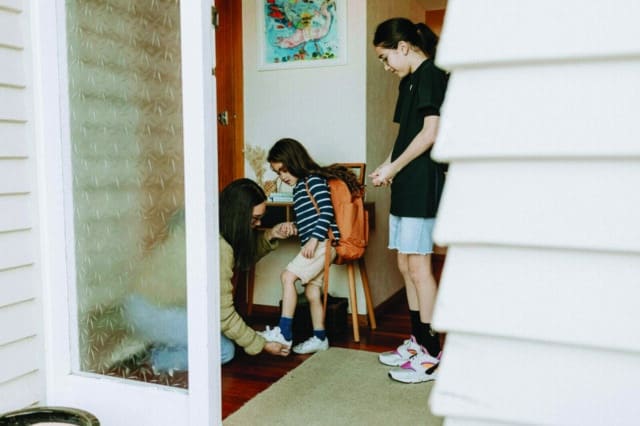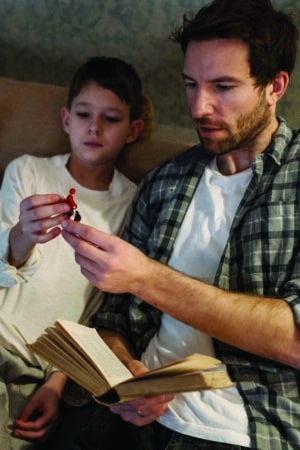The school drop-off can often be a time of stress and anxiety, writes researcher Emily Acraman for both the child and the whānau.

Whether starting school for the first time, changing schools or classrooms, returning after holidays, or adjusting to COVID-19 protocols, we have some hot tips for make mornings easier.
It can be difficult to differentiate between anxiety caused by being separated from a parent or caregiver, or anxiety about school in general.
Establishing the cause of the anxiety is important, and can be supported through solid relationship building, and creating a safe and comfortable space for the student to communicate this.
Alongside this, is the importance of easy and regular communication between key school staff, the student, and their whanau to ensure they are reading and listening to the student well. Often apprehension about school in general can present as separation anxiety.
One of our advisors recalls:
“When I was a younger teenager, I used to have meltdowns about school drop off which I guess could have looked like separation anxiety from the outside. But I wasn’t anxious about being separated from my parents, I was anxious about being at school”.
Creating a consistent morning routine
Beginning the day in a state of calm, as opposed to chaos, is important for successful transitions to school.
This starts at home and can be aided by the establishment of a clear and simple morning routine. For example, introducing a visual checklist of what needs to be done before leaving the house (i.e. having breakfast, brushing teeth, getting dressed etc).
At school, the unstructured times of the day are often the most challenging for autistic students (before and after school, break times etc). One of the ways to support is having consistent and predictable routines.
If the student is aware of the social and behavioural expectations, and has a clear routine to follow, this may help to alleviate some of the anxiety at drop-off time. The more prepared the student is for what the environment looks, feels and sounds like and how it performs, the more they can plan what they will do when they get there.
One of our advisors describes;
“The unstructured times at school are really scary. I hated any part of school that didn’t have structure as it required social skills and knowing what to say and do, and it was a chance for kids to be mean to each other without teachers paying attention”
Suggestions for successful morning routines include:
- Drop offs at the same time, by the same person
- Having the same teacher or educational professional greet the student when they arrive
- Follow a morning routine list, e.g. put books away, hang back up etc
- Use visuals where possible to reinforce this routine
- Having a choice of preferred activities for the student to engage in.
Incorporate a preferred activity
Incorporating the students’ preferred activity/activities in the morning routine is a great way to alleviate anxiety and helps to set the day up nicely.
Understanding the students’ preferences and giving them a choice of what they would like to engage in helps to make school a welcoming and non-threatening environment. Examples of this could include card games, reading, screen time, or giving the student a job (preparing for the day, or putting books away in the library etc).
Our advisors suggest:
“Setting up some structured fun activities that people can do before school- for example, having some games in the library or a before-school club focussed on something that piques the student’s interest could be a good idea. As I got older, I ended up having a couple of subjects where we had to take an extra class before school started, which meant I got to school and went straight to class- no annoying socialising involved! And when I was in year 6, our classroom maths box had lots of card decks that we would play with before school. That was good because you could just sit and watch people play and only join in if you wanted to”.
Providing a safe space
Another strategy that has been suggested by our advisory members, is having a safe or quiet space to retreat to before school starts.
One of our advisors mentions:
“When I was in years 7 and 9 and was really anxious about school drop-off, my parents used to walk me to the dean’s office and I would then sit quietly in the dean’s office until it was time for class to start. This mean I was being directly handed over to someone who could keep an eye on me so I couldn’t try to escape, but it also gave me a quiet space to adjust to the school environment, a chance to talk to the dean about anything that was worrying me, and it meant I could avoid the sometimes challenging before-school social time”.
Peer Inclusion
A common cause of anxiety for autistic people is a sense of being misunderstood and/or not accepted by non-autistic people. Thus, supporting autistic students with making friends and having others who accept and understand them is an important part of making the school experience manageable and enjoyable. One of our advisors noted school transitions were made easier by having neurodivergent friends that they met up with at the beginning of the school day. Peer inclusion could also be supported by assigning the student a friend or buddy, who helps with the morning routine.
Incorporating a special item
Another suggestion is for the student to bring to school a comforting item. It is, however, important to note that often displays of difference can be ill-treated by peers. Thus, this needs to be included or managed in a considered way. One of our advisors mentions:
“When I was at school I had a pencil case that looked like a toy dog; this provided comfort while being cleverly disguised as a practical object you need for school which alleviated bullying. I also sometimes took along a small teddy bear that was small enough to keep in my pocket, and a stim toy that was small enough to look like a keyring decoration”.
Parents role

Gradual introduction/withdrawal
Our advisory members also suggest gradual introduction/withdrawal may be helpful for some students. A gradual introduction involves starting a student on reduced hours (e.g., attending for part days) and gradually building up the time they spend at school. Gradual withdrawal on the other hand, involves gradually reducing a support measure as the student becomes more comfortable, or settled. An example of this may be the introduction of a support person who stays with the student as school, and slowly the support person spends less time with the students as they adjust to the environment.
A note on varying attendance hours:
Section 42 of the Education and Training Act enables a student’s parent (or full-time caregiver where appropriate), their principal and the Secretary for Education to agree to vary hours as part of a transitional attendance plan when the particular needs of the student require this. The plan must be requested by the parents only. It must be considered by all parties involved to be in the child’s best interests, and evidence will be required from a medical professional. The plan can be for no more than six months duration but can be renewed once only for a further period of up to six months.
In general, transition times can often be a trigger for anxiety in autistic children, this along with the added pressures of the school environment can make school drop off challenging. Acknowledging your child’s worries and learning what strategies will best support them is key.
-
Emily Acraman
Emily Acraman is a researcher for Altogether Autism.



